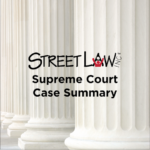While the Reconstruction Amendments were an important step in ensuring equal rights for all people, regardless of race, racial injustices throughout the United States continued into the late 19th and 20th centuries, leading to the Civil Rights movement of the 1960s, and the passages of Supreme Court decisions and legislation, including Brown v. Board of Education, the Civil Rights Act of 1964, and the Voting Rights Act of 1965. Visit the National Constitution Center’s learning module to learn more about the freedom struggle and civil rights.
Midterm Elections Matter
This lesson is intended to help students understand that midterm elections (whether they be for congressional candidates, governor, state representatives, or state initiatives) are equally as important as the presidential race every four years.
Different Treatment for Different Folks
The lesson begins with an illustration of the “separate but equal” doctrine – two water fountains are depicted, one labeled “colored” and the other labeled “white”. Students will discuss how this doctrine was used to justify separate treatment based on race, and that such a policy would not be legal today.
“American Skin” Song Analysis
Students will explore their ideas about fairness in the American criminal justice system and the role of race and ethnicity by analyzing the depiction of the Amadou Diallo shooting in Bruce Springsteen’s song “American Skin (41 Shots).” They will apply newly acquired knowledge about the protections and limits of the Fourth and 14th Amendment and law enforcement challenges to a reevaluation of their ideas about fair and equal treatment by the police.
Shaw v. Reno (1993)
Did the North Carolina residents’ claim that the 1990 redistricting plan discriminated on the basis of race raise a valid constitutional issue under the 14th Amendment’s Equal Protection Clause? North Carolina drew legislative districts to create a majority black district.
Parents Involved v. Seattle (2007)
Natural Rights, Citizenship Rights, State Rights, and Black Rights: Another Look at Lincoln and Race
In the real world, the ability of free blacks to enjoy their natural rights and exercise the privileges and immunities of citizenship depended on the states where they actually lived. When those states imposed a raft of legal discriminations on free blacks they cheapened the meaning of freedom and discounted the value of citizenship. I suspect this bothered Lincoln, but it wasn’t his issue. It would take other men and women, and another century of struggle, before “states rights” was abolished. Free registration for students and teachers required to access resource.
Election 2016 Case Study: Entering the Race
In 2016, 22 people led the field of Republicans and Democrats running for president. They were joined by about 1,800 third-party, fringe and joke candidates. But is this field as open as it seems?
Constitutional Index – Amendment 15 Suffrage-Race Clause
The Constitutional Index breaks down the U.S. Constitution by Section, Amendment, and Clause and contains broader topics and themes. These are used to cross-reference Library resources in an effort to annotate constitutional history.
Voting Rights in America Timeline
Supplement your students’ understanding of voting rights in the United States with this free downloadable timeline. This visual guide breaks down the history of voting rights across identities, and gives context to efforts to expand and limit voting access over time, through the lenses of our three branches of government and our federal system.
